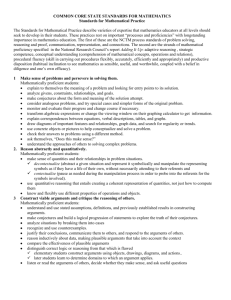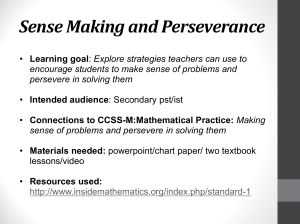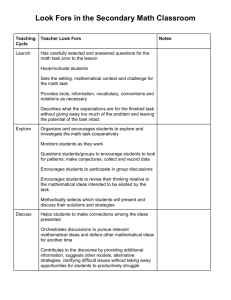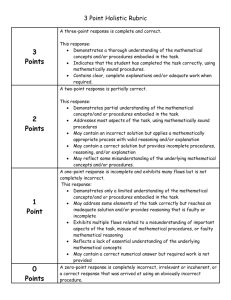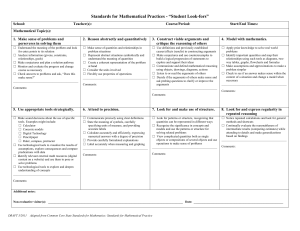CCSS Math Practices Elementary Elaborations
advertisement
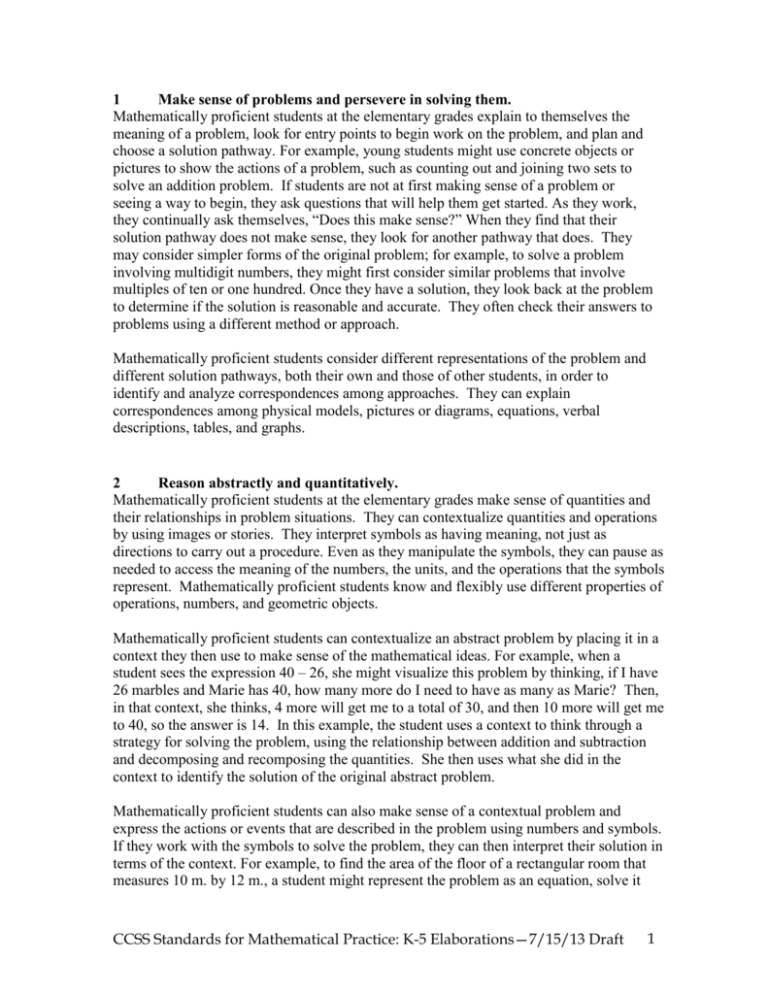
1 Make sense of problems and persevere in solving them. Mathematically proficient students at the elementary grades explain to themselves the meaning of a problem, look for entry points to begin work on the problem, and plan and choose a solution pathway. For example, young students might use concrete objects or pictures to show the actions of a problem, such as counting out and joining two sets to solve an addition problem. If students are not at first making sense of a problem or seeing a way to begin, they ask questions that will help them get started. As they work, they continually ask themselves, “Does this make sense?” When they find that their solution pathway does not make sense, they look for another pathway that does. They may consider simpler forms of the original problem; for example, to solve a problem involving multidigit numbers, they might first consider similar problems that involve multiples of ten or one hundred. Once they have a solution, they look back at the problem to determine if the solution is reasonable and accurate. They often check their answers to problems using a different method or approach. Mathematically proficient students consider different representations of the problem and different solution pathways, both their own and those of other students, in order to identify and analyze correspondences among approaches. They can explain correspondences among physical models, pictures or diagrams, equations, verbal descriptions, tables, and graphs. 2 Reason abstractly and quantitatively. Mathematically proficient students at the elementary grades make sense of quantities and their relationships in problem situations. They can contextualize quantities and operations by using images or stories. They interpret symbols as having meaning, not just as directions to carry out a procedure. Even as they manipulate the symbols, they can pause as needed to access the meaning of the numbers, the units, and the operations that the symbols represent. Mathematically proficient students know and flexibly use different properties of operations, numbers, and geometric objects. Mathematically proficient students can contextualize an abstract problem by placing it in a context they then use to make sense of the mathematical ideas. For example, when a student sees the expression 40 – 26, she might visualize this problem by thinking, if I have 26 marbles and Marie has 40, how many more do I need to have as many as Marie? Then, in that context, she thinks, 4 more will get me to a total of 30, and then 10 more will get me to 40, so the answer is 14. In this example, the student uses a context to think through a strategy for solving the problem, using the relationship between addition and subtraction and decomposing and recomposing the quantities. She then uses what she did in the context to identify the solution of the original abstract problem. Mathematically proficient students can also make sense of a contextual problem and express the actions or events that are described in the problem using numbers and symbols. If they work with the symbols to solve the problem, they can then interpret their solution in terms of the context. For example, to find the area of the floor of a rectangular room that measures 10 m. by 12 m., a student might represent the problem as an equation, solve it CCSS Standards for Mathematical Practice: K-5 Elaborations—7/15/13 Draft 1 mentally, and record the problem and solution as 10 12 = 120. He has decontextualized the problem. When he states at the end that the area of the room is 120 square meters, he has contextualized the answer in order to solve the original problem. Problems like this that begin with a context and are then represented with mathematical objects or symbols are also examples of modeling with mathematics (MP.4). 3 Construct viable arguments and critique the reasoning of others. Mathematically proficient students at the elementary grades construct mathematical arguments—that is, explain the reasoning underlying a strategy, solution, or conjecture—using concrete referents such as objects, drawings, diagrams, and actions. For example, in order to demonstrate what happens to the sum when the same amount is added to one addend and subtracted from another, students in the early grades might represent a story about children moving between two classrooms: the number of children in each classroom is an addend; the total number of children in the two classrooms is the sum. When some students move from one classroom to the other, the number of students in each classroom changes by that amount—one addend decreases by some amount and the other addend increases by that same amount—but the total number of students does not change. An older student might use an area representation to show why the distributive property holds. Arguments may also rely on definitions, previously established results, properties, or structures. For example, a student might argue that two different shapes have equal area because it has already been demonstrated that both shapes are half of the same rectangle. Students might also use counterexamples to argue that a conjecture is not true—for example, a rhombus is an example that shows that not all quadrilaterals with 4 equal sides are squares; or, multiplying by 1 shows that a product of two whole numbers is not always greater than each factor. Mathematically proficient students present their arguments in the form of representations, actions on those representations, and explanations in words (oral or written). In the elementary grades, arguments are often a combination of all three. Some of their arguments apply to individual problems, but others are about conjectures based on regularities they have noticed across multiple problems (see MP.8, Look for and express regularity in repeated reasoning). As they articulate and justify generalizations, students consider to which mathematical objects (numbers or shapes, for example) their generalizations apply. For example, young students may believe a generalization about the behavior of addition applies to positive whole numbers less than 100 because those are the numbers with which they are currently familiar. As they expand their understanding of the number system, they may reexamine their conjecture for numbers in the hundreds and thousands. In upper elementary grades, students return to their conjectures and arguments about whole numbers to determine whether they apply to fractions and decimals. For example, students might make an argument based on an area representation of multiplication to show that the distributive property applies to problems involving fractions. Mathematically proficient students can listen to or read the arguments of others, decide whether they make sense, ask useful questions to clarify or improve the arguments, and CCSS Standards for Mathematical Practice: K-5 Elaborations—7/15/13 Draft 2 build on those arguments. They can communicate their arguments, compare them to others, and reconsider their own arguments in response to the critiques of others. 4 Model with mathematics. When given a problem in a contextual situation, mathematically proficient students at the elementary grades can identify the mathematical elements of a situation and create a mathematical model that shows those mathematical elements and relationships among them. The mathematical model might be represented in one or more of the following ways: numbers and symbols, geometric figures, pictures or physical objects used to abstract the mathematical elements of the situation, or a mathematical diagram such as a number line, a table, or a graph, or students might use more than one of these to help them interpret the situation. For example, when students are first studying an operation such as addition, they might arrange counters to solve problems such as this one: there are seven animals in the yard, some are dogs and some are cats, how many of each could there be? They are using the counters to model the mathematical elements of the contextual problem—that they can split a set of 7 into a set of 3 and a set of 4. When they learn how to write their actions with the counters in an equation, 4 + 3 = 7, they are modeling the situation with numbers and symbols. Similarly, when students encounter situations such as sharing a pan of cornbread among 6 people, they might first show how to divide the cornbread into 6 equal pieces using a picture of a rectangle. The rectangle divided into 6 equal pieces is a model of the essential mathematical elements of the situation. When the students learn to write the name of each piece in relation to the whole pan as 1/6, they are now modeling the situation with mathematical notation. Mathematically proficient students are able to identify important quantities in a contextual situation and use mathematical models to show the relationships of those quantities, particularly in multistep problems or problems involving more than one variable. For example, if there is a Penny Jar that starts with 3 pennies in the jar, and 4 pennies are added each day, students might use a table to model the relationship between number of days and number of pennies in the jar. They can then use the model to determine how many pennies are in the jar after 10 days, which in turn helps them model the situation with the expression, 4 10 + 3. Mathematically proficient students use their model to analyze the relationships and draw conclusions. They interpret their mathematical results in the context of the situation and reflect on whether the results make sense, possibly improving the model if it has not served its purpose. As students model situations with mathematics, they are choosing tools appropriately (MP.5). As they decontextualize the situation and represent it mathematically, they are also reasoning abstractly (MP.2). CCSS Standards for Mathematical Practice: K-5 Elaborations—7/15/13 Draft 3 5 Use appropriate tools strategically. Mathematically proficient students at the elementary grades consider the tools that are available when solving a mathematical problem, whether in a real-world or mathematical context. These tools might include physical objects (cubes, geometric shapes, place value manipulatives, fraction bars, etc.), drawings or diagrams (number lines, tally marks, tape diagrams, arrays, tables, graphs, etc.), paper and pencil, rulers and other measuring tools, scissors, tracing paper, grid paper, virtual manipulatives or other available technologies. Proficient students are sufficiently familiar with tools appropriate for their grade and areas of content to make sound decisions about when each of these tools might be helpful, recognizing both the insight to be gained from their use as well as their limitations. Mathematically proficient students choose tools that are relevant and useful to the problem at hand. These include such tools as are mentioned above as well as mathematical tools such as estimation or a particular strategy or algorithm. For example, in order to solve 3/5 – ½, a student might recognize that knowledge of equivalents of ½ is an appropriate tool: since ½ is equivalent to 2 ½ fifths, the result is ½ of a fifth or 1/10. This practice is also related to looking for structure (MP.7), which often results in building mathematical tools that can then be used to solve problems. 6 Attend to precision. Mathematically proficient students at the elementary grades communicate precisely to others. They start by using everyday language to express their mathematical ideas, realizing that they need to select words with clarity and specificity rather than saying, for example, “it works” without explaining what “it” means. As they encounter the ambiguity of everyday terms, they come to appreciate, understand, and use mathematical vocabulary. Once young students become familiar with a mathematical idea or object, they are ready to learn more precise mathematical terms to describe it. In using representations, such as pictures, tables, graphs, or diagrams, they use appropriate labels to communicate the meaning of their representation. When making mathematical arguments about a solution, strategy, or conjecture (see MP.3), mathematically proficient students learn to craft careful explanations that communicate their reasoning by referring specifically to each important mathematical element, describing the relationships among them, and connecting their words clearly to their representations. Elementary students learn to use mathematical symbols correctly and can describe the meaning of the symbols they use. In particular, they understand that the equal sign denotes that two quantities have the same value, and can use it flexibly to express equivalences. For example, the equivalence of 8 and 5 + 3 can be written both as 5 + 3 = 8 and 8 = 5 + 3. Similarly, the equivalence of 6 + 2 and 5 + 3 is expressed as 6 + 2 = 5 + 3. CCSS Standards for Mathematical Practice: K-5 Elaborations—7/15/13 Draft 4 When measuring, mathematically proficient students use tools and strategies to minimize the introduction of error. From Kindergarten on, they count accurately, using strategies so that they include each object once and only once without losing track. Mathematically proficient students calculate accurately and efficiently and use clear and concise notation to record their work. 7 Look for and make use of structure. Mathematically proficient students at the elementary grades use structures such as place value, the properties of operations, other generalizations about the behavior of the operations (for example, the less you subtract, the greater the difference), and attributes of shapes to solve problems. In many cases, they have identified and described these structures through repeated reasoning (MP.8). For example, when younger students recognize that adding 1 results in the next counting number, they are identifying the basic structure of whole numbers. When older students calculate 16 9, they might apply the structure of place value and the distributive property to find the product: 16 9 = (10 + 6) 9 = (10 9) + (6 9). To determine the volume of a 3 4 5 rectangular prism, students might see the structure of the prism as five layers of 3 4 arrays of cubes. 8 Look for and express regularity in repeated reasoning. Mathematically proficient students at the elementary grades look for regularities as they solve multiple related problems, then identify and describe these regularities. For example, students might notice a pattern in the change to the product when a factor is increased by 1: 5 7 = 35 and 5 8 = 40—the product changes by 5; 9 4 = 36 and 10 4 = 40—the product changes by 4. Students might then express this regularity by saying something like, “When you change one factor by 1, the product increases by the other factor.” Younger students might notice that when tossing two-color counters to find combinations of a given number, they always get what they call “opposites”—when tossing 6 counters, they get 2 red, 4 yellow and 4 red, 2 yellow and when tossing 4 counters, they get 1 red, 3 yellow and 3 red, 1 yellow. Mathematically proficient students formulate conjectures about what they notice, for example, that when 1 is added to a factor, the product increases by the other factor; or that, whenever they toss counters, for each combination that comes up, its “opposite” can also come up. As students practice articulating their observations, they learn to communicate with greater precision (MP.6). As they explain why these generalizations must be true, they construct, critique, and compare arguments (MP.3). CCSS Standards for Mathematical Practice: K-5 Elaborations—7/15/13 Draft 5
